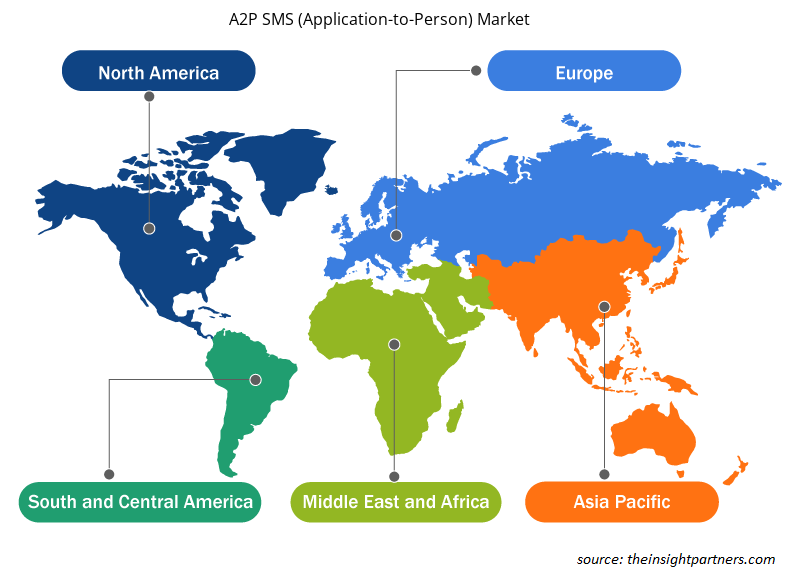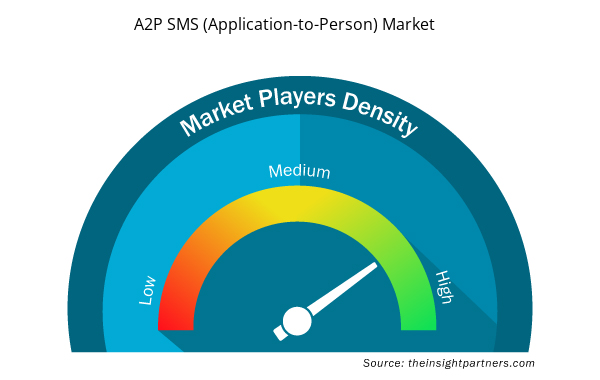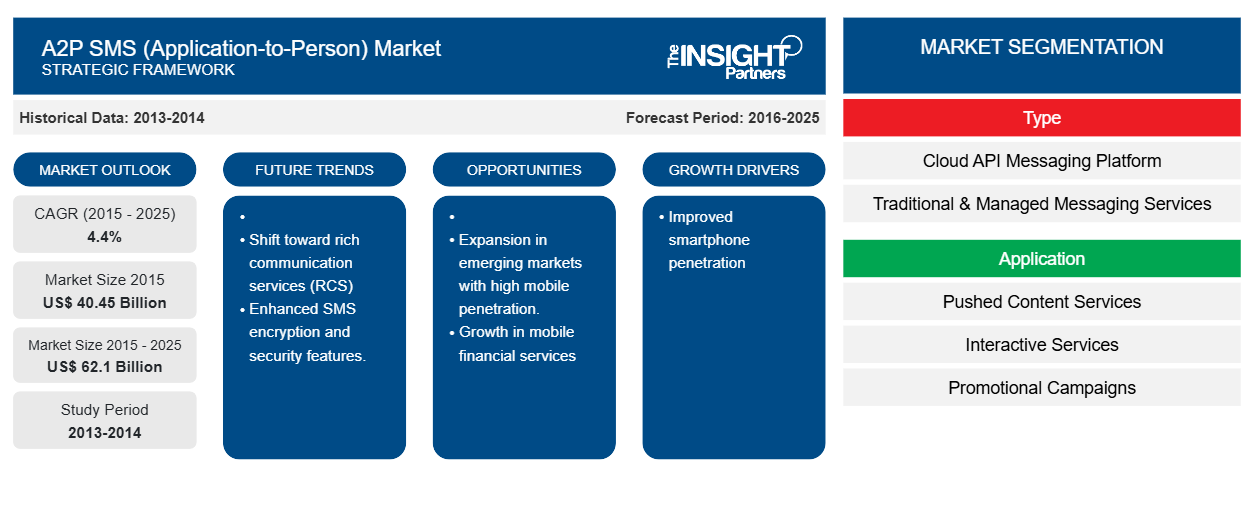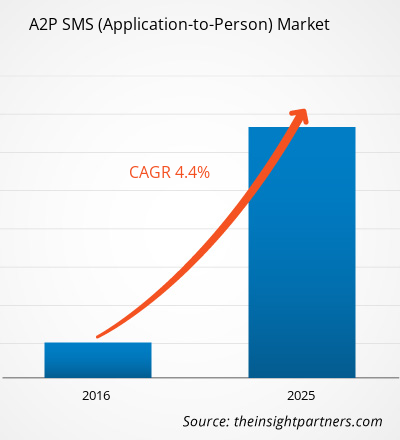Se estima que el mercado de SMS A2P crecerá a una CAGR del 4,4 % durante el período de pronóstico 2016 - 2025 y representará US$ 62,10 mil millones en el año 2025.
Los SMS A2P son la comunicación que se lleva a cabo entre una aplicación y un suscriptor a través de servicios de mensajería con diversos fines. Con la evolución de los teléfonos inteligentes acompañada de la aparición de actores OTT en el mercado, los operadores de redes móviles han visto una marcada caída en los ingresos obtenidos de los servicios de mensajería P2P (Peer-to-Peer). Sin embargo, ha habido un aumento paralelo en los ingresos por SMS A2P para los operadores de redes móviles a nivel mundial.
Personalice este informe según sus necesidades
Obtendrá personalización en cualquier informe, sin cargo, incluidas partes de este informe o análisis a nivel de país, paquete de datos de Excel, así como también grandes ofertas y descuentos para empresas emergentes y universidades.
- Obtenga las principales tendencias clave del mercado de este informe.Esta muestra GRATUITA incluirá análisis de datos, desde tendencias del mercado hasta estimaciones y pronósticos.
Los SMS pueden llegar a los clientes incluso en las zonas más remotas donde haya una conexión de red y, con el tiempo, se convierten en el modo más sencillo de comunicación con el cliente. A diferencia de los servicios de mensajería instantánea, el servicio de SMS puede funcionar en móviles estándar y básicos y no depende de una conexión a Internet para funcionar. El alcance y la flexibilidad de los servicios de SMS en comparación con los servicios en línea es mucho mayor y la ventaja de que los usuarios de móviles prepago sigan recibiendo mensajes de texto incluso si no tienen saldo le da a este modo una ventaja. Algunas de las características clave de la mensajería es que logra una mayor tasa de lectura en cuestión de minutos y cuenta con la tasa de participación más alta en comparación con los correos electrónicos y las aplicaciones de mensajería móvil OTT. Con el tiempo, dado que los clientes tienen más probabilidades de abrir los mensajes que los correos electrónicos, es evidente que el mercado de SMS A2P se verá impulsado debido a esto.
Cobertura del informe
En nuestro estudio, hemos segmentado el mercado de SMS A2PSMS market por tipo, aplicación, modelo de negocio y vertical. El segmento de tipo del mercado de SMS A2P incluye la plataforma de mensajería API en la nube y los servicios de mensajería tradicionales y gestionados. Sobre la base de las aplicaciones, el mercado de SMS A2P se segmenta ampliamente en servicios de contenido enviado, servicios interactivos, campañas promocionales, servicios de CRM y otros servicios. Además, el mercado de SMS A2P se bifurca sobre la base de verticales que tienen grandes aplicaciones de SMS A2P que incluyen BFSI, venta minorista, medios y entretenimiento, viajes y transporte, hospitalidad y otros sectores verticales que encuentran grandes aplicaciones de SMS A2P. Sobre la base de la geografía, el mercado de SMS A2P se analiza en América del Norte, Europa, Asia-Pacífico (APAC), Medio Oriente y África (MEA) y América del Sur (SAM). Uno de los principales factores que impulsan las demandas de adopción de SMS A2P es el creciente número de suscriptores de teléfonos móviles a nivel mundial, lo que lo convierte en dispositivos omnipresentes para fines de comunicación. El sector BFSI ha sido testigo de grandes desarrollos en la última década. La seguridad de los datos del consumidor y la importancia de las estrategias de marketing se han presentado como los factores principales al diseñar campañas A2P para cualquier vertical de la industria. La naturaleza ubicua de los servicios SMS ha favorecido significativamente el crecimiento del mercado de SMS A2P. Los mensajes A2P están siendo utilizados por bancos, instituciones de salud para recordatorios, venta de entradas para eventos móviles, contraseñas de un solo uso (OTP), actualizaciones de vuelos y trenes, actividades promocionales y concursos de encuestas, etc., por nombrar algunos. Para asegurarse de alcanzar el máximo alcance a los clientes, uno no puede confiar solo en los servicios de los reproductores OTT. En cambio, el alcance máximo se puede lograr a través de los servicios SMS. La razón es que, a nivel mundial, todavía en muchas regiones hay usuarios de teléfonos móviles que no se suscriben a servicios de Internet móvil. Como los reproductores OTT generalmente requieren conexión a Internet para garantizar la entrega de mensajes, los servicios SMS han sido los preferidos por las organizaciones en el pasado reciente.SMS market includes Cloud API Messaging Platform and Traditional & Managed Messaging Services. On the basis of applications the A2P SMS market is broadly segmented into Pushed Content Services, Interactive Services, Promotional Campaigns, CRM Services and Other Services. Moreover, the market for A2P SMS is bifurcated on the basis of vertical that have large applications of A2P SMSs that include BFSI, Retail, Media & Entertainment, Travel & Transport , Hospitality and other vertical sectors that find large applications of A2P SMSs. On the basis of geography, the A2P SMS market is analyzed into North America, Europe, Asia- Pacific (APAC), Middle East & Africa (MEA) and South America (SAM).
SMS adoptions is increasing number of mobile phone subscribers globally making it ubiquitous devices for communication purposes. BFSI sector has witnessed large developments in the last decade. Consumer data safety and the importance of marketing strategies has been put forth as the prime factors while designing A2P campaigns for any industry vertical. The ubiquitous nature of SMS services has favored the growth of A2P SMS market significantly A2P messages are being used by banks, healthcare institutions for reminders, mobile event ticketing, One Time Passwords (OTP), flight & train updates, promotional activities and polling contests etc. to name a few. To be assured of maximum reach out to the customers, one can’t rely only on the services of OTT players. Instead, the maximum reach out can be achieved through SMS services. Reason being, globally still in many regions there are mobile phone users who do not subscribe for mobile internet services. As the OTT players generally require internet connection to ensure the delivery of messages, SMS services have been preferred by organizations in the recent past.
Alcance del informe de mercado de SMS A2PSMS Market Report Scope
Perspectivas regionales del mercado de SMS A2P (aplicación a persona)
Los analistas de Insight Partners explicaron en detalle las tendencias y los factores regionales que influyen en el mercado de SMS A2P (aplicación a persona) durante el período de pronóstico. Esta sección también analiza los segmentos y la geografía del mercado de SMS A2P (aplicación a persona) en América del Norte, Europa, Asia Pacífico, Oriente Medio y África, y América del Sur y Central.

- Obtenga los datos regionales específicos para el mercado de SMS A2P (aplicación a persona)
Alcance del informe de mercado de SMS A2P (aplicación a persona)
| Atributo del informe | Detalles |
|---|---|
| Tamaño del mercado en 2015 | US$ 40,45 mil millones |
| Tamaño del mercado en 2025 | US$ 62.1 mil millones |
| Tasa de crecimiento anual compuesta (CAGR) global (2015-2025) | 4,4% |
| Datos históricos | 2013-2014 |
| Período de pronóstico | 2016-2025 |
| Segmentos cubiertos | Por tipo
|
| Regiones y países cubiertos | América del norte
|
| Líderes del mercado y perfiles de empresas clave |
|
Densidad de actores del mercado: comprensión de su impacto en la dinámica empresarial
El mercado de SMS A2P (de aplicación a persona) está creciendo rápidamente, impulsado por la creciente demanda de los usuarios finales debido a factores como la evolución de las preferencias de los consumidores, los avances tecnológicos y una mayor conciencia de los beneficios del producto. A medida que aumenta la demanda, las empresas amplían sus ofertas, innovan para satisfacer las necesidades de los consumidores y aprovechan las tendencias emergentes, lo que impulsa aún más el crecimiento del mercado.
La densidad de actores del mercado se refiere a la distribución de las empresas o firmas que operan dentro de un mercado o industria en particular. Indica cuántos competidores (actores del mercado) están presentes en un espacio de mercado determinado en relación con su tamaño o valor total de mercado.
Las principales empresas que operan en el mercado de SMS A2P (aplicación a persona) son:
- Tecnologías ANAM
- CLX Comunicaciones AB.
- DIMOCO Mensajería GmBH
- Infobip Ltda.
- Nexmo Inc. (adquirida por Vonage)
Descargo de responsabilidad : Las empresas enumeradas anteriormente no están clasificadas en ningún orden particular.

- Obtenga una descripción general de los principales actores clave del mercado de SMS A2P (aplicación a persona)
La penetración de Internet por parte de los usuarios de teléfonos móviles en el mundo sigue siendo baja. Mientras que en los países desarrollados la penetración de Internet por parte de los usuarios de teléfonos móviles es alta, en muchos países en desarrollo y subdesarrollados del mundo la penetración de Internet por parte de los teléfonos móviles es muy baja y los SMS son el medio de comunicación preferido para garantizar el máximo alcance. Este hecho confirma el aumento del uso del mercado de SMS A2P. Los actores clave perfilados en el informe son DIMOCO Messaging GmBH, AANAM Technologies, Twilio Inc., CLX Communications AB, Infobip Ltd., Syniverse Technologies, Vonage, tyntec, Tanla Solutions y Trillian Group Ltd.
- Análisis histórico (2 años), año base, pronóstico (7 años) con CAGR
- Análisis PEST y FODA
- Tamaño del mercado Valor/volumen: global, regional, nacional
- Industria y panorama competitivo
- Conjunto de datos de Excel



Report Coverage
Revenue forecast, Company Analysis, Industry landscape, Growth factors, and Trends

Segment Covered
This text is related
to segments covered.

Regional Scope
North America, Europe, Asia Pacific, Middle East & Africa, South & Central America

Country Scope
This text is related
to country scope.
Trends and growth analysis reports related to Technology, Media and Telecommunications : READ MORE..
The List of Companies
1. ANAM Technologies
2. CLX Communications AB.
3. DIMOCO Messaging GmBH
4. Infobip Ltd.
5. Nexmo Inc. (acquired by Vonage)
6. Syniverse Technologies, LLC
7. Tanla Solutions
8. Trillian Group Ltd.
9. Twilio Inc.
10. tyntec
The Insight Partners performs research in 4 major stages: Data Collection & Secondary Research, Primary Research, Data Analysis and Data Triangulation & Final Review.
- Data Collection and Secondary Research:
As a market research and consulting firm operating from a decade, we have published and advised several client across the globe. First step for any study will start with an assessment of currently available data and insights from existing reports. Further, historical and current market information is collected from Investor Presentations, Annual Reports, SEC Filings, etc., and other information related to company’s performance and market positioning are gathered from Paid Databases (Factiva, Hoovers, and Reuters) and various other publications available in public domain.
Several associations trade associates, technical forums, institutes, societies and organization are accessed to gain technical as well as market related insights through their publications such as research papers, blogs and press releases related to the studies are referred to get cues about the market. Further, white papers, journals, magazines, and other news articles published in last 3 years are scrutinized and analyzed to understand the current market trends.
- Primary Research:
The primarily interview analysis comprise of data obtained from industry participants interview and answers to survey questions gathered by in-house primary team.
For primary research, interviews are conducted with industry experts/CEOs/Marketing Managers/VPs/Subject Matter Experts from both demand and supply side to get a 360-degree view of the market. The primary team conducts several interviews based on the complexity of the markets to understand the various market trends and dynamics which makes research more credible and precise.
A typical research interview fulfils the following functions:
- Provides first-hand information on the market size, market trends, growth trends, competitive landscape, and outlook
- Validates and strengthens in-house secondary research findings
- Develops the analysis team’s expertise and market understanding
Primary research involves email interactions and telephone interviews for each market, category, segment, and sub-segment across geographies. The participants who typically take part in such a process include, but are not limited to:
- Industry participants: VPs, business development managers, market intelligence managers and national sales managers
- Outside experts: Valuation experts, research analysts and key opinion leaders specializing in the electronics and semiconductor industry.
Below is the breakup of our primary respondents by company, designation, and region:

Once we receive the confirmation from primary research sources or primary respondents, we finalize the base year market estimation and forecast the data as per the macroeconomic and microeconomic factors assessed during data collection.
- Data Analysis:
Once data is validated through both secondary as well as primary respondents, we finalize the market estimations by hypothesis formulation and factor analysis at regional and country level.
- Macro-Economic Factor Analysis:
We analyse macroeconomic indicators such the gross domestic product (GDP), increase in the demand for goods and services across industries, technological advancement, regional economic growth, governmental policies, the influence of COVID-19, PEST analysis, and other aspects. This analysis aids in setting benchmarks for various nations/regions and approximating market splits. Additionally, the general trend of the aforementioned components aid in determining the market's development possibilities.
- Country Level Data:
Various factors that are especially aligned to the country are taken into account to determine the market size for a certain area and country, including the presence of vendors, such as headquarters and offices, the country's GDP, demand patterns, and industry growth. To comprehend the market dynamics for the nation, a number of growth variables, inhibitors, application areas, and current market trends are researched. The aforementioned elements aid in determining the country's overall market's growth potential.
- Company Profile:
The “Table of Contents” is formulated by listing and analyzing more than 25 - 30 companies operating in the market ecosystem across geographies. However, we profile only 10 companies as a standard practice in our syndicate reports. These 10 companies comprise leading, emerging, and regional players. Nonetheless, our analysis is not restricted to the 10 listed companies, we also analyze other companies present in the market to develop a holistic view and understand the prevailing trends. The “Company Profiles” section in the report covers key facts, business description, products & services, financial information, SWOT analysis, and key developments. The financial information presented is extracted from the annual reports and official documents of the publicly listed companies. Upon collecting the information for the sections of respective companies, we verify them via various primary sources and then compile the data in respective company profiles. The company level information helps us in deriving the base number as well as in forecasting the market size.
- Developing Base Number:
Aggregation of sales statistics (2020-2022) and macro-economic factor, and other secondary and primary research insights are utilized to arrive at base number and related market shares for 2022. The data gaps are identified in this step and relevant market data is analyzed, collected from paid primary interviews or databases. On finalizing the base year market size, forecasts are developed on the basis of macro-economic, industry and market growth factors and company level analysis.
- Data Triangulation and Final Review:
The market findings and base year market size calculations are validated from supply as well as demand side. Demand side validations are based on macro-economic factor analysis and benchmarks for respective regions and countries. In case of supply side validations, revenues of major companies are estimated (in case not available) based on industry benchmark, approximate number of employees, product portfolio, and primary interviews revenues are gathered. Further revenue from target product/service segment is assessed to avoid overshooting of market statistics. In case of heavy deviations between supply and demand side values, all thes steps are repeated to achieve synchronization.
We follow an iterative model, wherein we share our research findings with Subject Matter Experts (SME’s) and Key Opinion Leaders (KOLs) until consensus view of the market is not formulated – this model negates any drastic deviation in the opinions of experts. Only validated and universally acceptable research findings are quoted in our reports.
We have important check points that we use to validate our research findings – which we call – data triangulation, where we validate the information, we generate from secondary sources with primary interviews and then we re-validate with our internal data bases and Subject matter experts. This comprehensive model enables us to deliver high quality, reliable data in shortest possible time.


 Obtenga una muestra gratuita de este informe
Obtenga una muestra gratuita de este informe